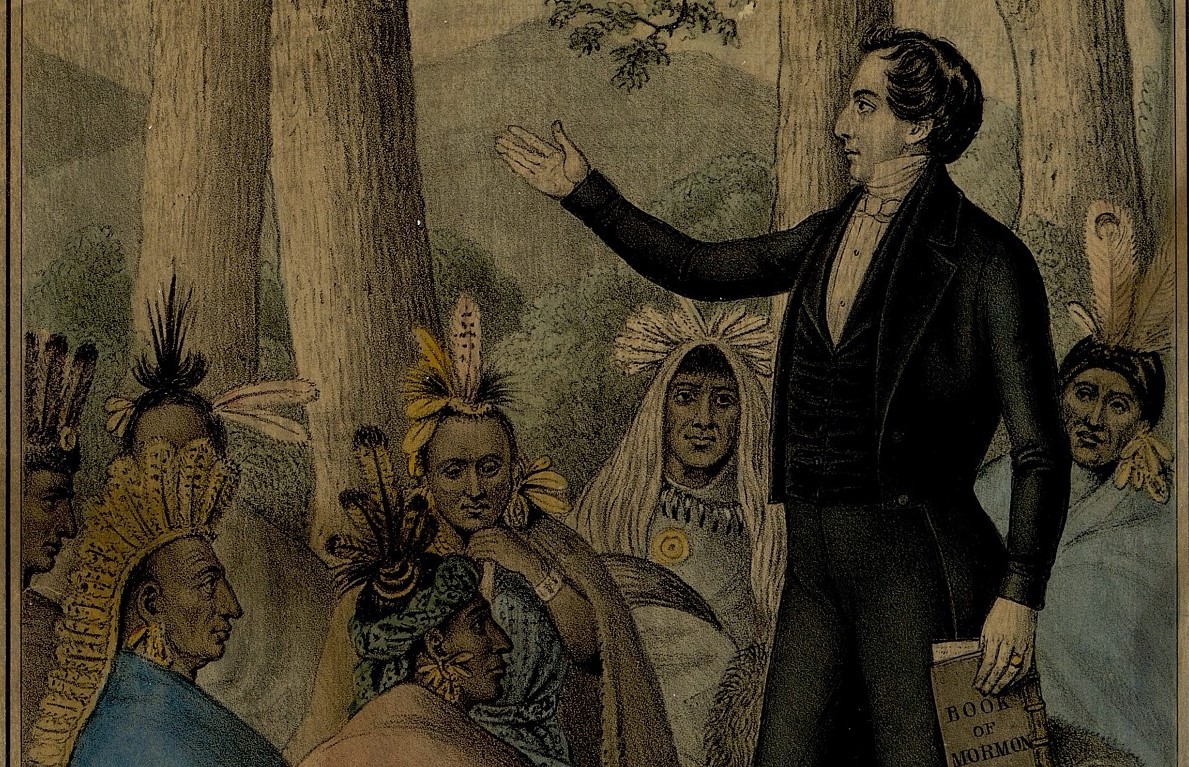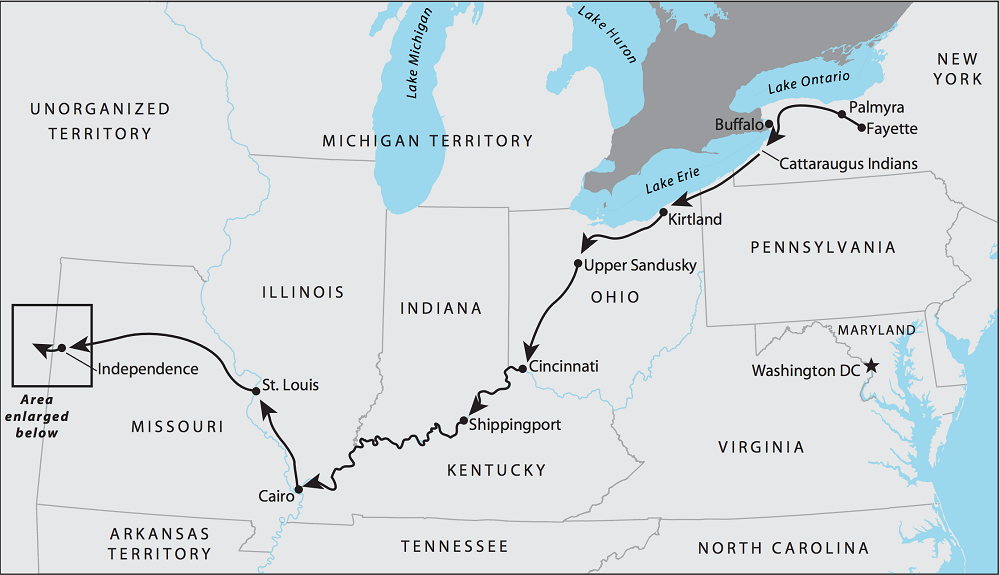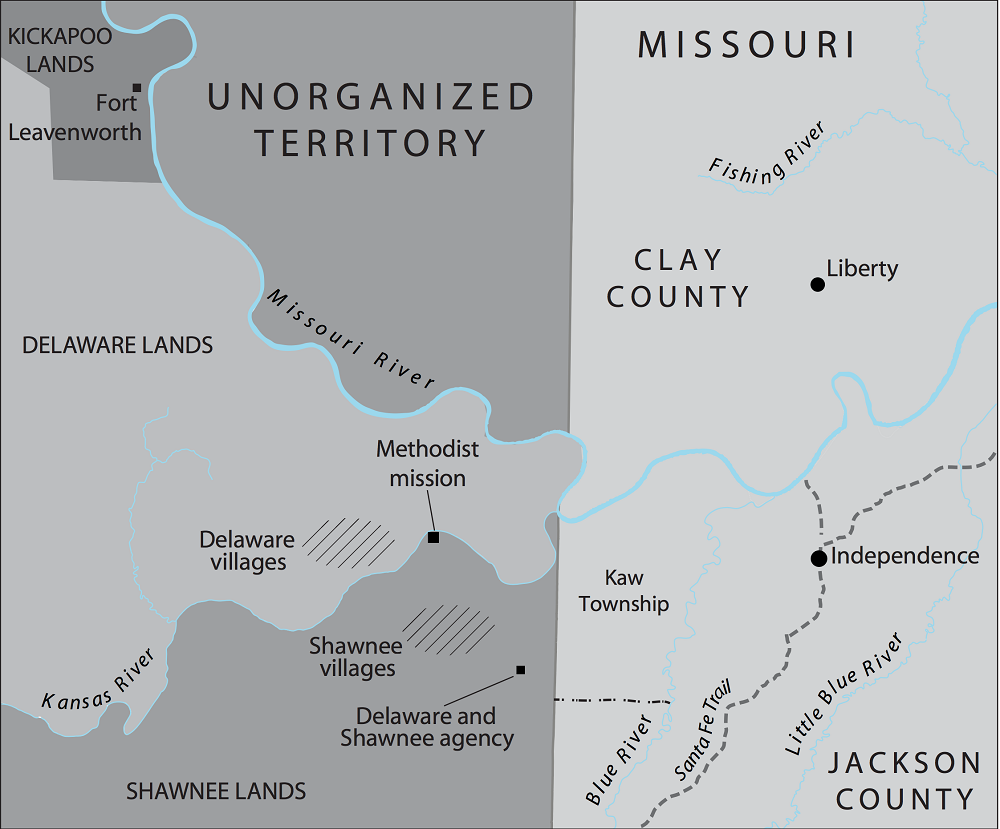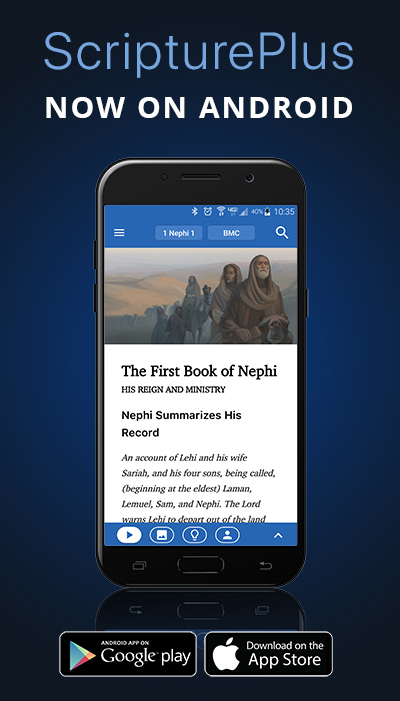/ KnoWhys / KnoWhy #486
Who Are the Lamanites?

Post contributed by BMC Team
November 20, 2018
D&C KnoWhy #486

“And I, Nephi, did take the sword of Laban, and after the manner of it did make many swords, lest by any means the people who were now called Lamanites should come upon us and destroy us”
The Know
Lamanites in the Book of Mormon
Shortly after their arrival in the land of promise, Nephi’s family split over increased tensions, chief among them being misplaced concerns that Nephi sought political dominance over the clan (2 Nephi 5:3). Being warned by the Lord to flee his brothers (v. 4), Nephi took his family members and “all those who would go with [him]” and fled into the wilderness (vv. 6–8).1 After founding a city, “all those who were with [Nephi] did take upon them to call themselves the people of Nephi” (v. 9), while those who remained with Nephi’s treacherous brothers were designated Lamanites (v. 14).
As generations passed, this two-fold structure (Nephite/Lamanite) broke down further into a more varied ethnic landscape. Jacob, Nephi’s younger brother, explained that within the Nephite/Lamanite categories were “Nephites, Jacobites, Josephites, Zoramites, Lamanites, Lemuelites, and Ishmaelites” (Jacob 1:13).2 Jacob further explained that by his day the ethnic labels “Nephite” and “Lamanite” were not neatly defined by strict biological parentage. Those who sought “to destroy the people of Nephi” Jacob called Lamanites, whereas “those who [were] friendly to Nephi [he called] Nephites, or the people of Nephi” (v. 14), regardless of their biological lineage.
This fluidity in the terms “Lamanites” and “Nephites” persisted throughout the history of Book of Mormon peoples. “Like the term Nephite,” researcher Matthew Roper explained, “the term Lamanite has a number of different meanings in scripture.”3 This includes:
- “Actual descendants of Laman, Lemuel, and the sons of Ishmael who followed Laman’s leadership after the death of Lehi (2 Nephi 5:1–6). Modern revelation indicates that among Lamanites today are some, yet to be revealed, who are descendants of Laman, Lemuel, and the sons of Ishmael and that they will one day receive a knowledge of the gospel (D&C 3:18).”
- “Those who did not believe in the warnings and revelations of God through Nephi (2 Nephi 5:6).”
- “Those not friendly to Nephi or the Nephites (2 Nephi 5:14; Jacob 1:13–14).”
- “Those who rejected and did not believe in the records and traditions of the Nephites (Alma 3:11).”
- “Those who intermarried with the Lamanites (Alma 3:9, 15).”
- “Those who fought against the Nephites (Alma 3:16).”
- “Any who dissented from the Nephites (Alma 3:17).”
- “Any led away by the Lamanites (Alma 3:10).”
- “Those who rejected the teachings of Christ, together with their children and ideological sympathizers (4 Nephi 1:38).”
- “After the destruction of the Nephites as a cohesive group, the seed of anyone who at any time had once been numbered with the ‘people of Nephi’ (Alma 45:13; cf. 45:14).”4
All of this indicates, as Hugh Nibley recognized, that the Book of Mormon’s “ethnological teachings . . . [are] surprisingly complicated.”5
The 1830–1831 “Lamanite Mission”


After the Book of Mormon was translated and published and the Church of Jesus Christ restored to the earth, the Lord directed through revelation that the Book of Mormon be taken “unto the Lamanites” (Doctrine and Covenants 28:8–9,14; cf. 3:18, 20; 30:6; 32:2; 49:24; 54:8), or, in other words, the Native Americans living in what was then the western frontier of the United States.6 The reason for this mission was, in part, because “the early Saints believed that all American Indians were the descendants of Book of Mormon peoples, and that they shared a covenant heritage connecting them to ancient Israel.”7
Accordingly, by the end of 1830, Oliver Cowdery, Parley P. Pratt, and other missionaries had embarked on a mission with the goal of preaching in Indian Territory west of the Mississippi River. Along the way, the missionaries taught members of the Seneca, Wyandot, and Delaware nations, among others. In a letter to Joseph Smith dated 7 May 1831, Oliver wrote of his desire to preach to “another tribe of Lamanites” who lived “three hundred miles west of Santa Fe [Mexico] and are called Navajos.”8 Unfortunately, interference from federal Indian agents prevented further missionary work among the Native Americans at that time.9
Lamanite Identity in the Restoration
During the lifetimes of Joseph Smith and Brigham Young, Latter-day Saint missionary work extended to the Pacific Islands, Mexico, and South America.10 As with earlier missionary efforts to native North American peoples, this new wave of proselyting emphasized the Lamanite identity of the native groups of these lands and promised them the blessings of Lehi.11
As the Church grew in North and South America and in the Pacific Islands, prophets continued to affirm the native peoples of these lands were children of Lehi.12 In 1959, then-Elder Spencer W. Kimball spoke to “our kinsmen of the isles of the sea and the Americas . . . Mexicans in Mexico; Guatemalans in Guatemala; Chilianos in Chile” and “Polynesians of the Pacific” and taught that “the Lord calls you Lamanites.”13
Lamanites and DNA Studies
In recent years, genetic evidence uncovered from DNA testing has revealed that Native Americans carry primarily Asian DNA.14 This has caused many to wonder how modern Native Americans could possibly be descendants of Lehi. Critics of the Book of Mormon have even used this evidence to argue for the book’s fraudulence.15 In 2014, the Church released an official statement on this subject which, while affirming Book of Mormon historicity, acknowledged the current state of the evidence, warned of the gaps in our knowledge, and urged for a nuanced approach in discussing Lamanite identity.16
This understanding is reflected in the updated introduction to the Church’s official edition of the Book of Mormon:
| LDS 1981 Edition of The Book of Mormon | LDS 2013 Edition of The Book of Mormon |
|---|---|
| “After thousands of years, all were destroyed except the Lamanites, and they are the principal ancestors of the American Indians.” | “After thousands of years, all were destroyed except the Lamanites, and they are among the ancestors of the American Indians.” |
As both the old and the new introductions to the Book of Mormon indicate, and as scholars have pointed out, Lehi could well be a common (but not sole) ancestor shared by most if not all modern Native Americans even if we cannot detect his DNA signature in his modern descendants because of complicating factors.17
The Why
This information is important in helping readers realize that the identity of those called Lamanites in the Book of Mormon is nuanced and complicated.18 Since the Book of Mormon very likely presents a scenario where Lehi’s descendants intermingled with peoples already present in the Americas,19 and since Church leaders historically have spoken of “Lamanites” in very broad terms,20 efforts to pinpoint which specific groups of Native Americans or Pacific Islanders are direct descendants of Lehi, whether by DNA testing or by interpreting the teachings of past prophets, is problematic.21 “The Church asserts that all members are part of the covenant house of Israel either by descent or adoption but does not take a position on the specific geography of the Book of Mormon or claim complete knowledge about the origins of any specific modern group in the Americas or the Pacific.”22
The Book of Mormon was written “to the Lamanites, who are a remnant of the house of Israel; and also to Jew and Gentile.” The express purpose of the book is to “show unto the remnant of the house of Israel what great things the Lord hath done for their fathers; and that they may know the covenants of the Lord, that they are not cast off forever” (Book of Mormon Title Page). As the Book of Mormon and prophets since the beginning of the Restoration have made clear, the modern native peoples of North and South America, or those with Native American ancestry, occupy an important place in the unfolding of God’s work among His children in the latter days.
The gospel of Jesus Christ is universal in its importance and applicability, and the Book of Mormon is written to all people as its all-encompassing audience. As Nephi taught, the Lord “inviteth [all men and women] to come unto him and partake of his goodness; and he denieth none that come unto him, black and white, bond and free, male and female; and he remembereth the heathen; and all are alike unto God, both Jew and Gentile” (2 Nephi 26:33). Those not of the house of Israel by natural birth may be adopted into the Abrahamic covenant by accepting the fullness of the gospel as revealed in the Book of Mormon (1 Nephi 14:1–2; 2 Nephi 10:18; 3 Nephi 21:6, 22; 30:1–2).23
In a memorable passage, Mormon wrote of an idyllic period after Jesus established his church among Lehi’s descendants when there was no warfare or ethnic strife. “There were no robbers, nor murderers, neither were there Lamanites, nor any manner of –ites,” he recorded, “but they were in one, the children of Christ, and heirs to the kingdom of God” (4 Nephi 1:17). This is the ultimate goal promoted in the Book of Mormon and sought after by followers of Christ today.
Further Reading
Matthew Roper, “Nephi’s Neighbors: Book of Mormon Peoples and Pre-Columbian Populations,” FARMS Review 15, no. 2 (2003): 91–128.
Matthew Roper, “Swimming in the Gene Pool: Israelite Kinship Relations, Genes, and Genealogy,” FARMS Review 15, no. 2 (2003): 129–164.
D. Jeffrey Meldrum and Trent D. Stephens, “Who Are the Children of Lehi?” Journal of Book of Mormon Studies 12, no. 1 (2003): 38–51, 116.
Hugh Nibley, Since Cumorah, The Collected Works of Hugh Nibley: Volume 7 (Salt Lake City and Provo, UT: Deseret Book and FARMS, 1981), 215–220.
“American Indians,” Church History Topics, online at www.history.lds.org.
“Lamanite Identity,” Church History Topics, online at www.history.lds.org.
Richard Dilworth Rust, “A Mission to the Lamanites,” Revelations in Context, online at www.history.lds.org.
1. The “others” spoken of in this verse are most likely non-Lehite indigenous peoples. See Book of Mormon Central, “Did Interactions with ‘Others’ Influence Nephi’s Selection of Isaiah?” KnoWhy 45 (March 2, 2016); “Did ‘Others’ Influence Book of Mormon Peoples?” KnoWhy 435 (May 22, 2018); “How Many Others Traveled with Lehi to the Promised Land?” KnoWhy 465 (September 6, 2018).
2. See further Book of Mormon Central, “Why Did Lehi Divide His People into Seven Tribes?” KnoWhy 319 (May 29, 2017).
3. Matthew Roper, “Swimming in the Gene Pool: Israelite Kinship Relations, Genes, and Genealogy,” FARMS Review 15, no. 2 (2003): 153, emphasis in original.
4. Roper, “Swimming in the Gene Pool,” 153.
5. Hugh Nibley, Since Cumorah, The Collected Works of Hugh Nibley: Volume 7 (Salt Lake City and Provo, UT: Deseret Book and FARMS, 1981), 215. “The Book of Mormon is careful to specify that the terms Lamanite and Nephite are used in a loose and general sense to designate not racial but political (e.g., Mormon 1:9), military (Alma 43:4), religious (4 Nephi 1:38), and cultural (Alma 53:10, 15; 3:10–11) divisions and groupings of people. The Lamanite and Nephite division was tribal rather than racial, each of the main groups representing an amalgamation of tribes that retained their identity (Alma 43:13; 4 Nephi 1:36–37).”
6. Richard Dilworth Rust, “A Mission to the Lamanites,” Revelations in Context, online at www.history.lds.org; “American Indians,” Church History Topics, online at www.history.lds.org.
7. See “American Indians,” Church History Topics, online at www.history.lds.org.
8. Letter from Oliver Cowdery, 7 May 1831, online at http://www.josephsmithpapers.org/paper-summary/letter-from-oliver-cowdery-7-may-1831/1, spelling standardized.
9. For overviews of the so-called Lamanite Mission, see Max H. Parkin, “Lamanite Mission of 1830–1831,” in Encyclopedia of Mormonism, ed. Daniel H. Ludlow (New York, NY: Macmillan, 1992), 2:802–804; Ronald W. Walker, “Seeking the ‘Remnant’: The Native American during the Joseph Smith Period,” Journal of Mormon History 19, no. 1 (1993): 1–33, esp. 5–11; Ronald E. Romig, “The Lamanite Mission,” The John Whitmer Historical Association Journal 14 (1994): 25–33; Grant Underwood, “The Mission to the Lamanites,” in Joseph: Exploring the Life and Ministry of the Prophet, ed. Susan Easton Black and Andrew C. Skinner (Salt Lake City, UT: Deseret Book, 2005), 144–155; Marlene C. Kettley, Arnold K. Garr, and Craig K. Manscill, “Mission to the Lamanites, 1830–31,” in Mormon Thoroughfare: A History of the Church in Illinois, 1830–39 (Provo, UT: Religious Studies Center, Brigham Young University, 2006), 1–11; Saints: The Story of the Church of Jesus Christ in the Latter Days (Salt Lake City, UT: The Church of Jesus Christ of Latter-day Saints, 2018), 97–99, 115–117.
10. R. Lanier Britsch, Unto the Islands of the Sea: A History of the Latter-day Saints in the Pacific (Salt Lake City, UT: Deseret Book, 1986); Lauri F. Maffly-Kipp, “Looking West: Mormonism and the Pacific World,” Journal of Mormon History 26, no. 1 (Spring 2000): 40–63; David J. Whitaker, “Parley P. Pratt and the Pacific Mission: Mormon Publishing in ‘That Very Questionable Part of the Civilized World’,” in Mormon Scripture and the Ancient World: Studies in Honor of John L. Sorenson, ed. Davis Bitton (Provo, UT: FARMS, 1998), 51–84; A. Delbert Palmer, “Hoping to Establish a Presence: Parley P. Pratt’s 1851 Mission to Chile,” BYU Studies 38, no. 4 (1999): 115–138; Richard O. Cowan, “Beginnings in South America,” in Unto Every Nation: Gospel Light Reaches Every Land, ed. by Donald Q. Cannon and Richard O. Cowan (Salt Lake City, UT: Deseret Book, 2003), 254–271; Reid L. Neilson et al., eds., Regional Studies in Latter-day Saint Church History: The Pacific Isles (Provo and Salt Lake City, UT: Religious Studies Center and Deseret Book, 2008); Jason H. Dormady, “The Mormons in Mexico,” in Just South of Zion: The Mormons in Mexico and its Borderlands, ed. Jason H. Dormady and Jared M. Tamez (Albuquerque, NM: University of New Mexico Press, 2015), 1–22.
11. For instance, in 1851 Elder Parley P. Pratt, who had been a missionary with Oliver Cowdery during the Lamanite Mission of 1830–1831, wrote a proclamation in which he announced, “Peruvians, Mexicans, Guatemalans, descendants of every tribe and tongue of this mysterious race, your history, your gospel, your destiny is revealed. . . . [God] purposes your restoration as a righteous branch of Israel. The Book of Mormon, the record of your fathers, will soon be published among you . . . so that to say the least you may have the gospel of your forefathers, and some knowledge of their history and prophecies.” Parley P. Pratt, Proclamation! To the People of the Coasts and Islands of the Pacific; of Every Nation, Kindred, and Tongue (Sydney, Australia: C.W. Wandell, 1851), 9–10, spelling standardized. One year later Pratt similarly proclaimed, “Spanish Americans! A vast majority of you are the descendants of the ancient race of the Mexican, Peruvian, Chilean and other nations of original Americans. The origin of that entire race is now revealed . . . by the discovery and translation of their ancient records (the Book of Mormon). . . . And you, their descendants, are known in their ancient records as Lamanites, Nephites, etc.” Parley P. Pratt, Proclamation Extraordinary! To the Spanish Americans (San Francisco, CA: Monson, Haswell, 1852), 13–14, emphasis in original, spelling standardized.
12. John-Charles Duffy, “The Use of ‘Lamanite’ in Official LDS Discourse,” Journal of Mormon History 34, no. 1 (Winter 2008): 118–167, esp. 126–151.
13. Spencer W. Kimball, “To You . . . Our Kinsmen,” Improvement Era, December 1959, 938. At the dedication of the Mexico City Mexico Temple in 1983, President Gordon B. Hinckley supplicated, “Bless Thy saints in this great land and those from other lands who will use this temple. Most have in their veins the blood of Father Lehi. Thou hast kept Thine ancient promise. Many thousands ‘that walked in darkness have seen a great light.’” Gordon B. Hinckley, “Dedicatory Prayer,” Mexico City Mexico Temple, December 2, 1983, online at https://www.lds.org/temples/details/mexico-city-mexico-temple/prayer/1983-12-02.
14. See Ugo A. Perego et al., “The Initial Peopling of the Americas: A Growing Number of Founding Mitochondrial Genomes from Beringia,” Genome Research 20, no. 9 (2010); Ugo A. Perego et al., “Distinctive Paleo-Indian Migration Routes from Beringia Marked by Two Rare mtDNA Haplogroups,” Current Biology 19, no. 1 (2009): 1–8.
15. See Thomas W. Murphy, “Lamanite Genesis, Genealogy, and Genetics,” in American Apocrypha: Essays on the Book of Mormon, ed. Dan Vogel and Brent Lee Metcalf (Salt Lake City, UT: Signature Books, 2002), 47–77; Simon G. Southerton, Losing a Lost Tribe: Native Americans, DNA, and the Mormon Church (Salt Lake City, UT: Signature Books, 2004).
16. “Nothing is known about the extent of intermarriage and genetic mixing between Book of Mormon peoples or their descendants and other inhabitants of the Americas, though some mixing appears evident, even during the period covered by the book’s text. What seems clear is that the DNA of Book of Mormon peoples likely represented only a fraction of all DNA in ancient America. Finding and clearly identifying their DNA today may be asking more of the science of population genetics than it is capable of providing.” See “Book of Mormon and DNA Studies,” online at https://www.lds.org/topics/book-of-mormon-and-dna-studies?lang=eng. See further Daniel C. Peterson, ed., The Book of Mormon and DNA Research (Provo, UT: Neal A. Maxwell Institute for Religious Scholarship, 2008); Book of Mormon Central, “Why Hasn’t Lehi’s DNA Been Found?” KnoWhy 280 (2017).
17. Roper, “Swimming in the Gene Pool,” 159–163; Brian D. Stubbs, “Elusive Israel and the Numerical Dynamics of Population Mixing,” FARMS Review 15, no. 2 (2003): 165–182; D. Jeffrey Meldrum and Trent D. Stephens, “Who Are the Children of Lehi?” Journal of Book of Mormon Studies 12, no. 1 (2003): 38–51, 116; Who Are the Children of Lehi? DNA and the Book of Mormon (Salt Lake City, UT: Greg Kofford Books, 2007), esp. 85–91; Smith, “Often in Error, Seldom in Doubt: Rod Meldrum and Book of Mormon DNA,” FARMS Review 22, no. 1 (2010): 86–88; Jayne E. Ekins and Ugo A. Perego, “Is Decrypting the Genetic Legacy of America’s Indigenous Populations Key to the Historicity of the Book of Mormon?” Interpreter: A Journal of Mormon Scripture 12 (2014): 273.
18. See “Lamanite Identity,” Church History Topics, online at www.history.lds.org.
19. John L. Sorenson, “When Lehi’s Party Arrived in the Land, Did They Find Others There?” Journal of Book of Mormon Studies 1, no. 1 (1992): 1–34; Matthew Roper, “Nephi’s Neighbors: Book of Mormon Peoples and Pre-Columbian Populations,” FARMS Review 15, no. 2 (2003): 91–128.
20. Duffy, “The Use of ‘Lamanite’ in Official LDS Discourse,” 118–167.
21. See “Book of Mormon and DNA Studies,” which cautions, “Much as critics and defenders of the Book of Mormon would like to use DNA studies to support their views, the evidence is simply inconclusive.” See further Matthew Roper, “Losing the Remnant: The New Exclusivist ‘Movement’ and the Book of Mormon,” FARMS Review 22, no. 2 (2010): 87–124; Ugo A. Perego, “The Book of Mormon and the Origin of Native Americans from a Maternally Inherited DNA Standpoint,” in No Weapon Shall Prosper: New Light on Sensitive Issues, ed. Robert L. Millet (Provo, UT: Religious Studies Center, Brigham Young University, 2011), 171–217.
22. See “Lamanite Identity,” Church History Topics, online at www.history.lds.org.
23. Russell M. Nelson, “The Gathering of Scattered Israel,” Ensign, November 2006, 79–81.

